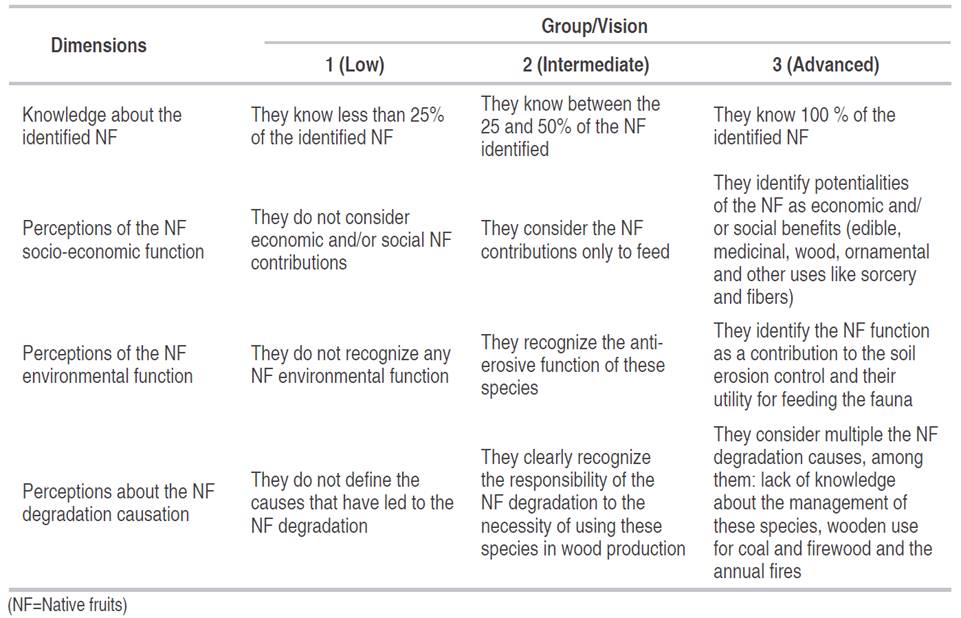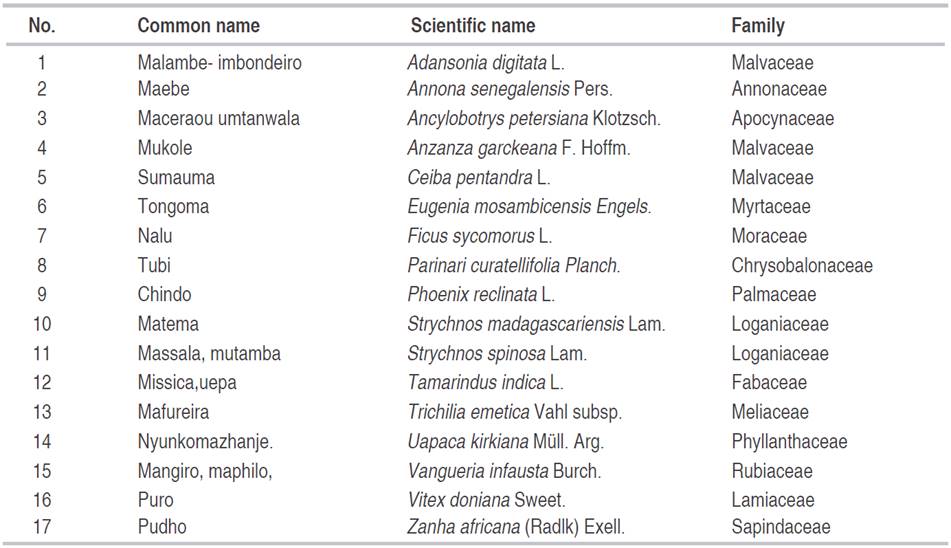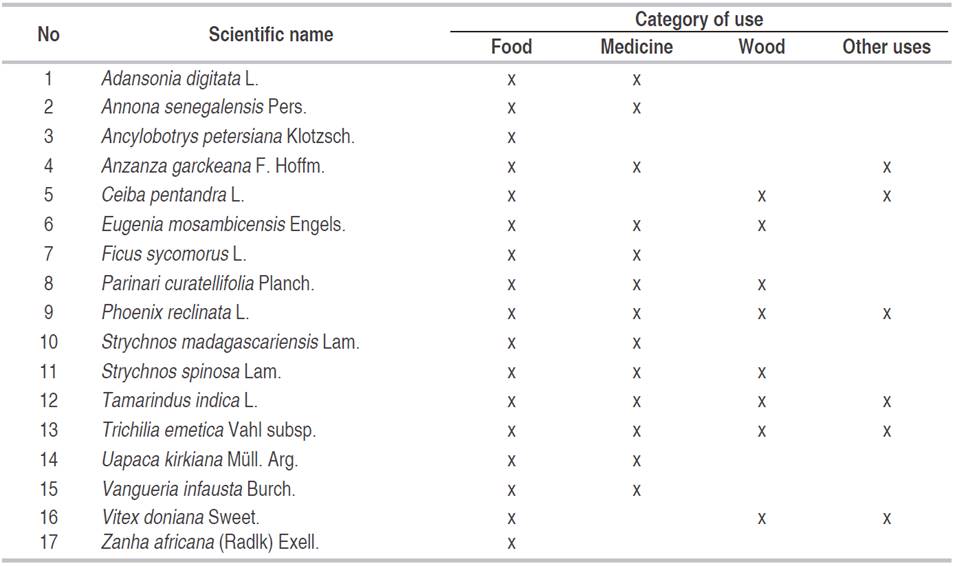Native fruits (NF) in Mozambique are very diverse. Although many of them show broad perspectives of economic use, only a few of them have been studied at both the local and national level. At the same time, the current transfer of scientific and technical knowledge and business opportunities have an incipient value in new productive chains. Besides, a significant part of the indigenous knowledge for the protection of the forest ecosystem has not been considering (Simone, 2001).
The use and logging of the native fruit trees have become into an important practice for the subsistence of rural communities, not only during the seasonal periods of hunger but also in their day-to-day for the nutritious consumption. It must be kept in mind their good adaptability to arid areas without requiring the use of fertilizers, making them more accessible to the rural community, due to their low cost of production and acquisition (Goulão and Santo-Antonio, 2015).
Native fruit trees also play an important role in the traditional medicine and represent a high potential of economic exploitation, in the promotion of employment opportunities and the improvement of the family profit within the rural populations (Chiau, 2003).
Several native fruits, which can contribute to the solution of the alimentary crisis, have been identified within the forest ecosystems in Mozambique. However, the inadequate use and constantly logging are a concern due to their contribution to the decrease in the population of these fruit species, regardless of their importance for the nutritious diet in the Mozambican rural population.
Munhiba is a municipality of the district of Mocuba in which the nutrition security depends on a large part of the production and availability of food coming from a heterogeneous agricultural sector of smallholders, as well as a small incomplete and not well-distributed commercialization network. Agricultural production is characterized by low productivity due to the weak use of technology and incomes. Consequently, the production percentage that reaches the market is low (MAE, 2005).
The low levels of rainfall that have been registered in Munhiba during the last period have placed its population under challenging situations to access to food supplies (nutrition insecurity). Under those conditions, the native fruits have been the fundamental mean of sustenance of local population.
Castro Paulino Comrade, the representative of Food and Agriculture Organization of the United Nations in Mozambique, underlined in the First National Workshop of Native Fruits, that the research in the native area of the fruits in Mozambique is still in its initial phase. He also asserted: “The research, domestication, and development processes of the valuable native fruits chains should deserve a special attention because 70% of the population live in rural areas and almost 80% depend on the natural resources, like fruits and medicinal plants to satisfy the nutritional and health necessities”(Goulão and Santo-Antonio, 2015).
These arguments evidence the necessity to find alternatives to commit the community in the self-management of their natural resources, a subject that has been debated in different trends and socio-political situations along the history of the practical social thinking (Reyes, 2013).
According to Brivio Borja (2001), the community self-management is an administration of the community that occurs due to the transformation of the descending spiral of poverty in an upward spiral of development. The source of the community self-management is the change from a fatalistic vision of the poverty, only as a summary of lacks, to a hopeful vision as a generator of the necessary impulse for development. The community self-management is the channel through which the inherent infinite potential of the human being is canalized toward the achievement of a worthy life, through improving the life quality of each one of the inhabitants. It also allows them to achieve their objectives and goals with solidary support of their fellow men; taking advantage of all the resources of the community, that in this case it is adjusted to the natural resources (native fruit trees).
A worldwide emphasis has been developed toward the managing processes at the community level. Several researchers converge in the topic based on the creation of participative processes that lead to the emergence of a critical popular conscience to understand the social practice as an inseparable unit of reflection and action. Referring to the case some authors such as Valdés (2010), Mitjans (2012), Sabogal et al. (2012), Molero et al. (2012), Reyes (2013), and Marzin et al. (2014); which offer an updated and in-depth focus on the community actions from the participation and self-management with emphasis in an economic, social, and the environmental scope.
In this research, the self-management is represented as a suitable alternative to the local communities that inhabit the forest ecosystems of Mozambique. They need to be articulated among them to established functions in pro of the forest and their well-being. Therefore, the following hypothesis is presented: if it is considered the economic and environmental perception, as well as the knowledge, that the local actors of the community of Munhiba have about the native fruits of the region; it will be possible to elaborate working lines to contribute with an appropriate management of these native fruits. Regarding the former idea, this research centers its objective in proposing some lines of work for the community of Munhiba that contribute to an appropriate self-management of the native fruits.
MATERIALS AND METHODS
Localization of the study area
Munhiba municipality is located in the central part of Mozambique, in the county of Zambézia, district of Mocuba. It limits to the North with the Headquarters of the District of Mocuba, to the South with the district of Namacurra, to the East with the district of Maganja da Costa trough the Licungo River, and to the West with the town of Namanjavira (MA, 2011).
Methodology used
To assess the economic, environmental, and social perception of the local actors about the native fruits, identify the causes of their deterioration and recognize the strengths and weaknesses for the community development; both quantitative and qualitative research methods were used. Considering the Ethnographic prevalence, the criteria of Rodríguez et al. (2008) were used; given that they declared that the study of the Ethnographic is a research method from which it is possible to know the way of life of a specific social unit. Besides, the Participatory Rapid Diagnosis (PRD) was used, following the criteria of Gomes et al. (2001) who identify the PRD as the approach most used to facilitate the direct participation of the residents in the generation and the analysis of the obtained information.
For gathering the information, a semi-structured interview along with a simple and participant observation was used to increase the validity of the study and also to obtain a better understanding of the studied context, keeping in mind the approaches proposed by Dewalt and Dewalt (2002).
It was performed an intentional sampling to apply the interview. 118 residents were selected out of a universe of 326 to be interviewed. Three exchange workshops and six field visits were carried out to identify the native fruit species that were in the forest that limits the area where the community inhabits.
For the selection of interviewees, it was taking into consideration those who live up to 2 km of distance away from the forest. The sample size for the research was to determine following the procedures for social studies in finite populations during the estimation of a proportion, presented by Calero Vinelo (1978). A confidence level (1-α) of 95% with a significance level (α) of 5% and a critical value (Z) of 1.96, as well as a positive variability (p) of 0.95 and a negative variability (q) of 0.05 were considered, assuming a maximum permissible error (E) of 0.05.
Where:
n: sample size.
Z: level of confidence.
p: positive variability.
q: negative variability.
N: size of the population.
For the interpretation of the interview results, a variable codifier was used (Table 1). The information processing was carried out with the statistical package IBM-SPSS, version 20.0.
For the statistical analysis, non-parametric tests were carried out. It was used Bi-varied correlation using the coefficient of correlation, Rho of Spearman, to determine the strength of the linear relation among the categorical variables. The evaluation of the perception of local actors was also made through a descriptive analysis, based on frequency distributions with the graphics generator.
In order to identify the fruit species taxonomically, there were used not only the criteria of Specialists in Botany and Dendrology from the Agronomy and Forestry Engineering Faculty of Zambeze University, but also the traditional knowledge of the more experienced local actors and the technical record on fruit species proposed by the FAO (1982). Furthermore, an ethnobotanical study was also carried out to assess the strength of the area for the use of the located species. They were classified in: groceries, medicinal, wood, ornamental, sorcery, water store, as well as soil and water protectors.
RESULTS AND DISCUSSION
Perception of local actors on the NF and their relation with the proximity to the forest
During the study of the perception of local actors on the environmental function, it is appreciated that 68 of the interviewees (58%) possess a low vision, because they did not recognize any environmental function of the fruits; out of them, 49 individuals live at a distance between one and two kilometers from the forest. For an advanced vision, 38 individuals were identified, from which 34 live in the forest proximity. In general, it is observed that from the 61 interviewees that live inside the forest area and in its periphery, 40 somehow considered environmental importance of the native fruits, and 19 discarded all environmental value of these species (Figure 1).
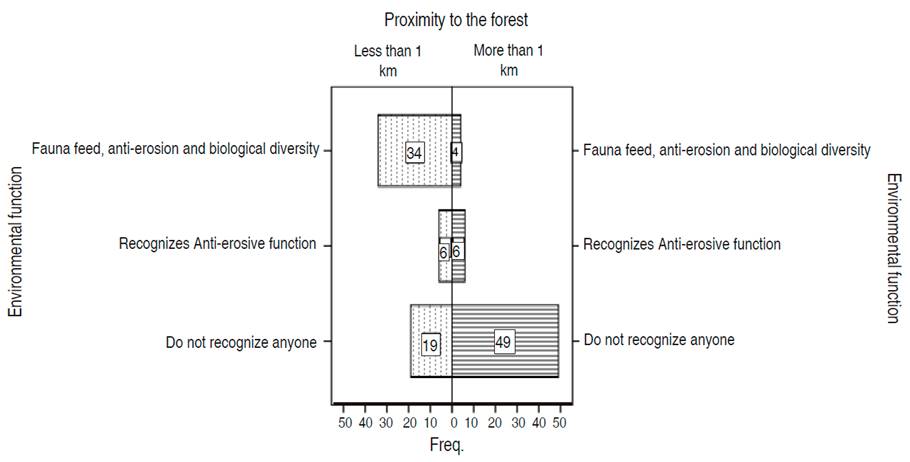
Figure 1 Distribution of frequencies according to the perception of the local actors on the environmental function related to the distance to the forest.
Figure 2 shows the relationship between the causes of deterioration and the economic importance that is attributed to the fruit species. It is also appreciated that the largest number of individuals is in the low vision (1) who do not define the causes of deterioration (84/118) (71%), 12 of them do not attribute any benefit, while 72 of them consider its use only as food. So, it can be inferred that if these local actors were qualified about the economic importance of the fruits, they would have been motivated to diminish the causes of deterioration and to self-negotiate the management of the fruits.
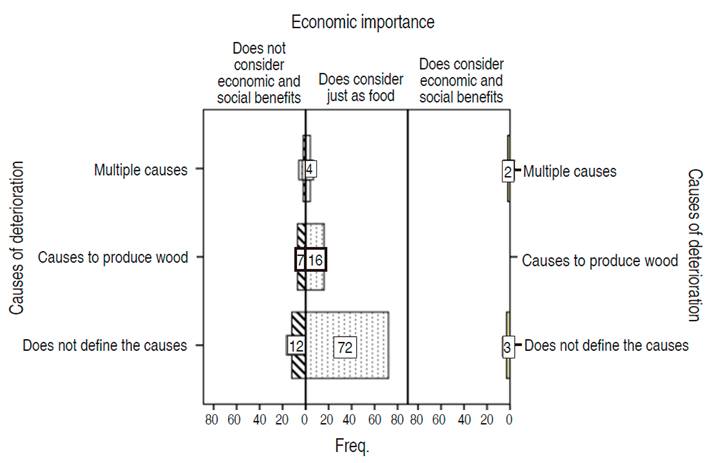
Figure 2 Distribution of frequencies according to the perception of the local actors about the causes of deterioration and economic importance.
About this concern, AIDER and FAO (2016) declared that “the training becomes the first step toward the self-help to take responsibilities on their destination, or what is known as self-management.”
It is necessary to train them, for them to be able to make use of the forest resources, including the native fruits. These strategies of multiple uses would allow them to maintain a dual economy. On the one hand, they have production areas from which they sell some goods and services, and on the other hand, they satisfy their necessities of local consumption (García-Frapolli et al., 2008; Infante-Ramírez, 2011; Infante-Ramírez and Arce Ibarra, 2013).
Figure 3 shows the relationship between the proximity to the forest and the knowledge of the fruit species. In this case, the positions were favorable because all the local actors were in the advanced and intermediate positions, so they indeed know the native fruit species. It is observed that the 87% identify the 100% of the fruits (103/118) and that the largest representativeness of them (58) comes from those who live nearer the forest. The latter is an important question to be kept in mind according to the criteria of Mitjans (2012), due to the people know their region, the traditional use of the natural resources, the location of the species and in some cases the way of plants propagation. These factors are important inquiries to be considered in the management plan of the different forest ecosystems.
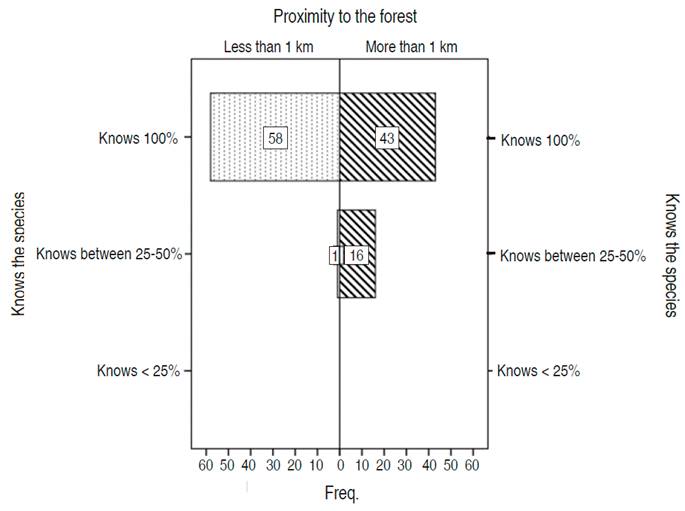
Figure 3 Distribution of frequencies according to the perception of the local actors on knowledge of the species and proximity to the forest.
According to Moreno (2013), during the last decades some geographers, anthropologists, sociologists, historians, naturalistic, jurists, among other specialists have continued the task of describing and building theories about the collective rural institutions and their knowledge and perceptions about the natural resources.
Concerning the knowledge of the species in function of the school level of the local actors, it was verified that all of them know the native fruits since they were in the visions 2 and 3. 85% (100/118) of the interviewees know the 100% of native fruit species. Individuals in low positions were not found (Figure 4).
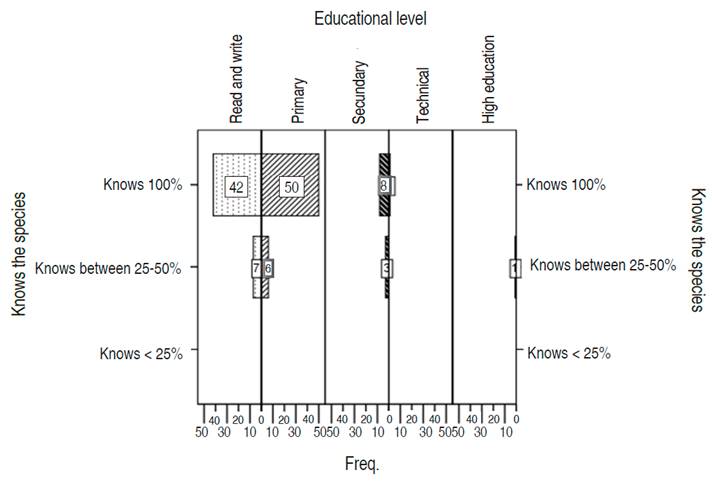
Figure 4 Distribution of frequencies according to the perception of the local actors on knowledge of the species and the school level.
Traditional knowledge and the local actors participated in the administration of the natural resources should be considered during their management. Molina-Pelegrín et al. (2011) obtained important results concerning protected and conserved areas, with the intervention of the adjacent communities.
Likewise, Vargas Larreta (2013) asserted that it is necessary to use the local and traditional knowledge about the biodiversity to incorporate it in the forest planning and management to guarantee better results in their conservation.
On the other hand, Jiménez (2012) alluded to the relation between the anthropic action and distance from the forest, asserting that local players who are close to the forest know the species and their uses.
According to Packham (1993), although it exists a growing awareness of the importance of the wild fruits and other non-mature stand products from the forests, it is still a very little knowledge of their importance to keeping the families safe during difficult climatic, nutrition, and financial periods. This short literature review seems to show that the social and economic security should be attributed to the highly diverse environment that sustains these forested areas of Miombo (Africa). The perception of the local actors on the environmental function was contrasted with the knowledge they had about the species, resulting in all local actors know the fruit species, while only the 46% recognized their environmental importance (Figure 5).
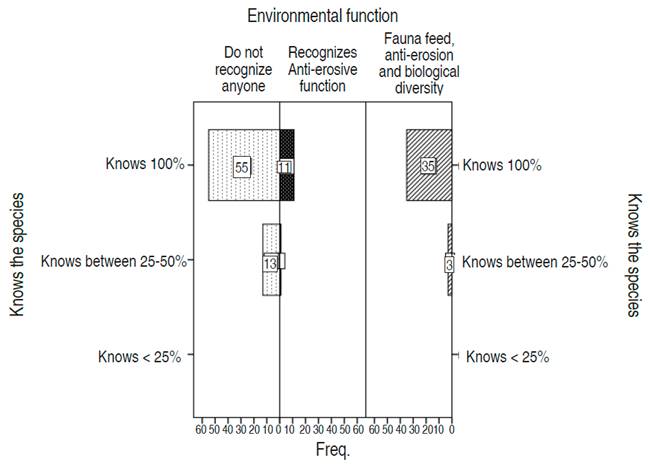
Figure 5 Distribution of frequencies according to the local actors’ perception of the environmental function and the knowledge about the species.
The environmental perception is an important element to consider for the environmental administration since it reinforces the responsibility level and the local actors’ right to the forest (Mitjans, 2012).
From the results of the correlation analysis (Table 2) by applying the coefficient of Rho of Spearman, it is observed a significant relationship between the variables causes of deterioration and economic importance. The relation among these variables is inverse, which indicates that the lower the economic importance, the increasing in the causes of deterioration. It is conditioned by the lack of knowledge about the economic, environmental, and nutrition importance of the native fruits. It is an issue of great importance for the African countries since different studies in other parts of this continent have concluded that the wild fruits provide an important dietary component, mainly to the children (Packham, 1993).
Strengths and weaknesses found in the community of Munhiba
During the participatory diagnosis were also identified strengths and weaknesses that allowed to propose a group of working lines to facilitate the participatory NF self-management by the community of Munhiba.
Strengths
There is a diversity of NF species in the community.
Suitable edafo-climatic and ecological condition for NF production.
Conducted studies show that Mozambique’s NF have potential uses (feeding, medicine, the industry of cosmetics, building supplies, wood, and extraction of essential oils).
Many of the NF are protected by beliefs and traditional myths.
Most of the local actors use the NF as the staple and daily food due to the economic situation and precarious conditions in which they inhabit.
There is an available budget for projects on feeding.
Simple technology and low-cost expenses will be required if local actors are included in the handling of NF.
A high percentage (82%) of the interviewees knew 100% of the NF of the study area.
Weaknesses
Limited community knowledge on NF nutritional security.
The absence of systematic and participatory approaches through which the community could negotiate its patrimony in an effective participatory way.
Insufficient availability of upgraded technical people in the community institutions to conduct NF research and production processes.
Inadequately qualified technicians in the necessary research areas.
Insufficient technical support for the producers.
Low applied investment in the research and implementation projects on NF.
There is not an intentioned production and processing of NF, so it responds to the necessities of the community.
The community does not value the NF importance to improve their economy and quality of life.
There is not an integral economic, environmental and social perception to facilitate the suitable NF self-management.
Faulty environmental management that leads to the NF exploitation from inadequate uses, as it is the felling for firewood and coal.
Insufficient training of the community on the participatory processes in NF administration and use.
Annual practices of forest fires in the herbaceous stratum where the NF are.
These elements related to the strengths and weaknesses show that it is necessary to promote community work. According to the approaches of Reyes et al. (2017), it becomes more and more opportune and indispensable for the economic and social development of a country.
Just as it is reflected in Table 3, there were identified 17 native fruits species, distributed in 14 families and 16 genders, which are used for feeding, the control of the illnesses, and sorcery; as the local actors identify in a territory. The family with more representative species is Malvaceae with three species (Adansonia digitata L., Anzanza garckeana F. Hoffm, and Ceiba pentandra L.).
It is important to underline that some of the NF species found in the area were already studied by Cândido (2011) in the district of Quissanga, such as the case of Annona senegalensis, Ancylobotrys petersiana, Phoenix reclinata, Adansonia digitata, Ceiba pentandra, Strychnos madagascariensis, Tamarindus indica, Trichilia emetica, Anzanza garckeana, Vangueria infausta, Zanha africana, and Vitex doniana. This author explained that they are widely used as food and commercialized by the local actors.
Table 4 shows different uses of the species by category. Among the species three of them (Phoenix reclinate L., Tamarindus indica L., and Trichilia emetica Vahl subsp) have a wide scope of uses.
Out of the 118 interviewees, 77 (65%) declared that they eat the leaves of the Ceiba peltandra and its toasted seeds.
Among the identified species, it was found the Strychnous madagascariensis, which is used as a food and medicine, has been yet studied by Inguane et al. (2015). They found in it a considerable percentage of sugars, lipids, proteins, macronutrients (K, Na, Mg, and Ca), micronutrients (Cu, Ni, Zn, Mn, and F), as well as a content of vitamin A, alkaloids, and saponins (anti-cholesterol and anti-cancer). A high nutritional and medicinal potential can be exploited for nutrition security during scarcity periods.
Striycnos spinosa Lam. It is a fruit used for feeding, liquor production, and in the traditional medicine for illnesses treatment. Other authors like Munyemana et al. (2015) found similar results in conducted studies.
Among the interviewees, 79% (93/118) identified the NF as a necessary food and medicine source for their life development.
Working lines proposed for the NF self-management in the community of Munhiba
The inadequate NF management caused insufficient protection of them, leading to the damage of forest ecosystem, where they are. Besides, not taking advantage of their total benefit as nutritious potential and source of employments and earnings for the local actors in the community of Munhiba.
The proposed working lines aim to place the local actors as the immediate beneficiaries; they leaned on in their suggested ideas (from the groups’ discussion) to help the promotion of a functionally participatory development process under a sociocultural vision. These work lines have been figured out as follows:
To carry out exchange participatory meetings with the community and the institutions, applying participatory technics to the creation of democratic knots that allow, in a combined way, the decision-making about the NF management.
Upgrading the population’s knowledge, both individual and collective, to assume in a participatory way the administration of the NF in their territory.
To elaborate and bring into the forest management, practical plans with an integral and holistic vision of the forest ecosystem, with specificities in the NF; contributing with intellectual instruments and supported on methodological tools that allow accessing and building up an environmental knowledge.
Designing and implementing integrated programs, to maximize the use and exploit the potential of each species.
To identify the more outstanding NF at the economic level and to adopt measures for their great scale domestication and production.
Implementing programs of secondary and high education students’ formation, as well as technical education level in different application areas to the NF.
To document the local knowledge on NF (ethnobotanical studies) and to create mechanisms of popularization of the local know-how.
Promoting in the community the nutritive, medicinal, and commercial importance that have the NF.
To train the local actors in how to manage the NF.
To make a catalog that provides information regarding NF nutrition security and the collateral benefits for their management in a participative way.
To carry out protection practices against fires, pests, diseases, and anthropogenic activities.
CONCLUSIONS
The developed diagnosis and its analysis facilitated to verify the limited participation and local actors’ knowledge (producers, processors, and merchants of fruits) from Munhiba town. The lack of work lines was also verified for a community self-management, so that contributes to its production and commercialization.
Despite the degradation by the man’s influence in the study area, it is evident the high potential of NF mean for the community, mainly as edible, medicinal, and wood use, represented by 17-identified species; some of them of high commercial value as Vangueria infausta (Mangiro), Strychnos spinosa (Massala) and Trichilia emetica (Mafurra).
The working lines for NF self-management proposals in the community of Munhiba are based in the developed diagnosis and the theoretical conceptions, and they are conceived to be executed with a participatory social focus that contributes to their appropriate management.














